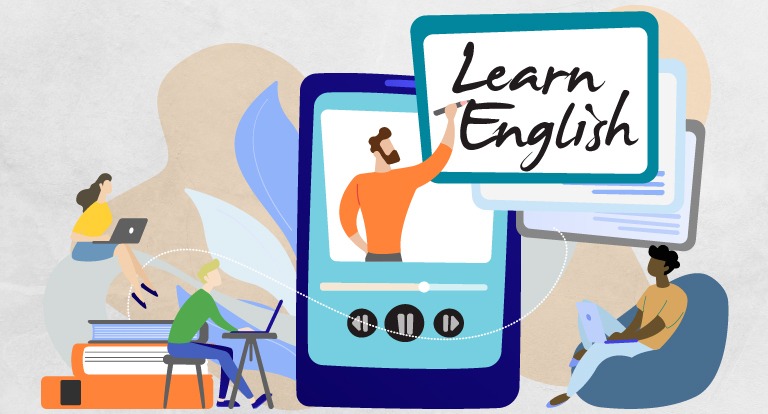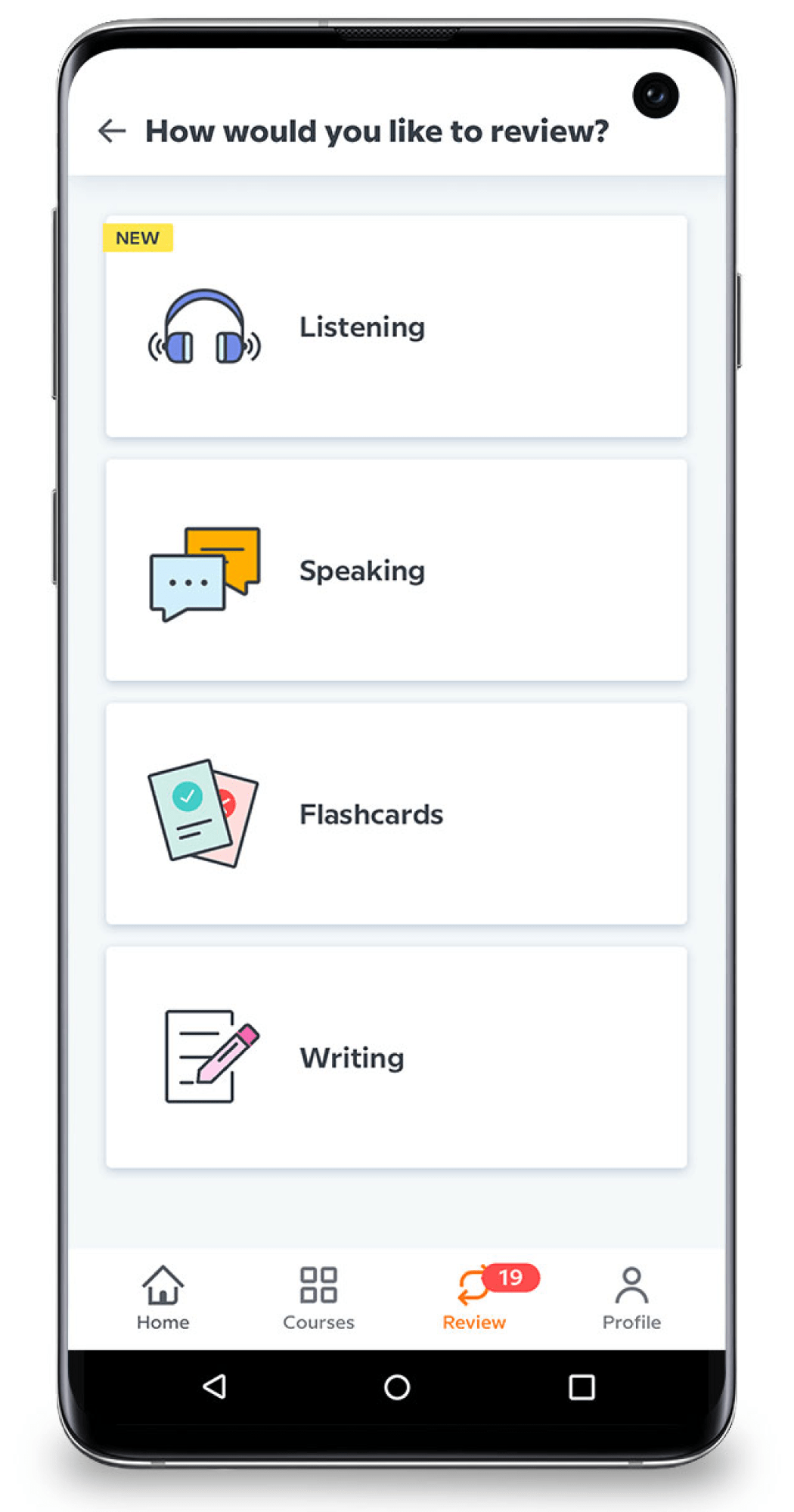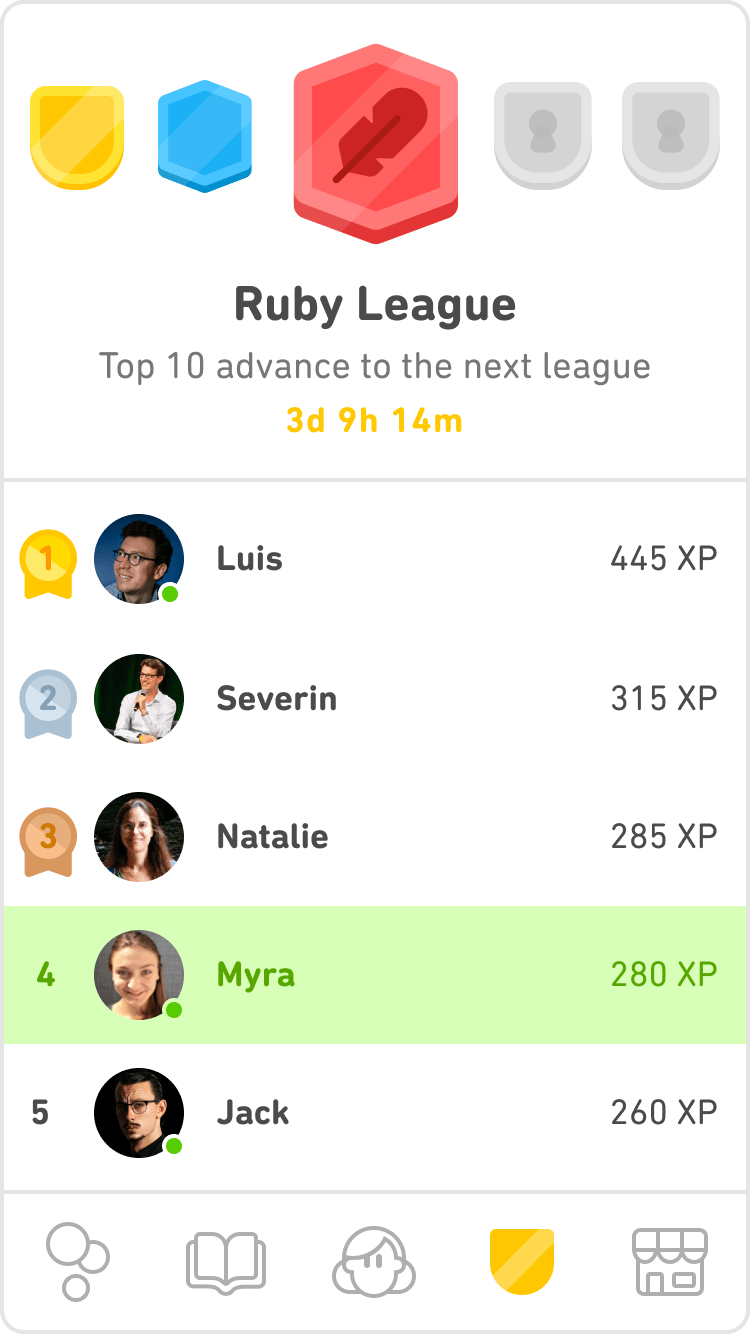The concept of English learning is all around us. Opportunities to learn languages at our workplaces or in our communities serve as ways to bring people together and to provide valuable new skills. Friends and co-workers compete on language learning platforms as if the platforms were video games; students are motivated to learn by using fun mobile and web applications (apps) during their studies.
English, Spanish, French and German are favorites amongst students, given their relevance in the business world. However, learning a language can also be a way of developing a unique skill out of sheer curiosity, which is why some choose to learn a rare language to adopt a broader perspective of the world and other cultures.
We are now truly interconnected at all times, and languages interweave worlds that used to be far apart. When it comes to learning English, we are now just a click away from connecting with teachers or entering an online course, with the help of apps.
Under Lockdown? Learn a New Language!
COVID-19 forced us to socialize less and make use of our spare time in practical ways, such as learning a new language. In March and April of 2020, over 30 million new learners joined the language learning app Duolingo – 67% more than the previous year.
As soon as the world went into lockdown, Duolingo competitor Babbel’s existing learners became more active as well.
“Learners finished twice as many learning activities per day than usual. Learners that started during COVID are our most active in Babbel’s history. Our hypotheses why? One, it gives structure in lockdown days; two, [it provides] meaningful use of time after the first two BBC or Netflix series; and three, [users have] sufficient time commitment to build a habit,” said Rachel Toner, the international public relations manager at Babbel.
In March and April of 2020, over 30 million new learners joined the language learning app Duolingo – 67% more than the previous year.
Language learning app companies saw an opportunity as the world collectively moved online last year. Babbel offered its services for free for three months to students, and as a result, more than 150,000 people took up courses. The new reality also required changes regarding the content. At Babbel, they replaced all of the commute- and travel-related conversations with other topics.
Mobile language learning apps have enjoyed popularity not only with teachers and students but also with professionals who wish to access better economic opportunities. Language learning opens up doors in business which, in turn, significantly impacts national economies.
The use of simple language learning apps is shaking up our world: we are not only becoming globally interconnected, but we are also expressing evolving and robust interests regarding other cultures and languages. Language apps can do more than just make learning easier and more widespread. They also increase the number of people who are at least somewhat familiar with the lingua franca of higher education and business: English. The features of mobile technology, such as portability and information accessibility, play a significant role in enhancing English language teaching and learning.
Unleashing the Digital Era in the Classroom and Beyond
Not only has our world turned upside down since the widespread use of the internet and technology, but traditional English language teaching methods have also significantly changed. Methods relying on technological innovations are more efficient in keeping students’ attention, according to researchers.
At the beginning of the expansion of these innovations, many educators and researchers were concerned regarding technology’s role in distracting people, but today most understand that without its use, teaching becomes “old-school,” and does not meet the needs of modern English learners. Mobile phones also used to have a bad reputation among educators and parents, and even this is changing in most classrooms.
One study that was focused on the value mobile technologies add to English learning found its main benefits are increased motivation to study English, improved learner performance – specifically in the area of vocabulary, more personalized language learning, high levels of interactivity, a diversity of readily available resources, collaboration and autonomy.
Mobile phones also used to have a bad reputation among educators and parents, and even this is changing in most classrooms.
For apps to be a successful educational tool, it’s key that teachers and students try to focus on their positive aspects rather than their limitations and restrictions. Teachers may gain respect from their students by allowing technology to enter the classroom, by relying on different methods to teach languages, and by unlocking a vast new set of resources and abilities.
Since the world around us has changed, new learning methodologies are welcomed by students, who often prefer activities that incorporate technology over conventional classroom activities. The best way to combine traditional teaching methods with language learning apps is to mix and match. Let students have a break when they seem to be losing attention and they will become productive again. Language school operators might also attract students by focusing on the use of technology and the resulting increased productivity.
English learning and teaching have spread outside the classroom setting, too. We are now experiencing the era of lifelong learning, and apps provide a solution for just about everything people are interested in, from languages to investment. Furthermore, the trend is strengthened by businesses around the globe motivating their workers to become proficient in English.
Certain language learning apps, such as Cambly, serve as platforms that give students the opportunity to practice conversational English or attend courses. Cambly offers special courses focused on business English and professional development in areas like interviewing, giving presentations and running a startup.
Complementing Traditional English Teaching
Most apps have sophisticated teaching methods, such as gamification and audio-focused lessons. Some apps have also built a reputation by offering quizzes and making it easier for teachers to test their students’ knowledge. While certain apps are designed to help students learn vocabulary and enhance word and phrase repetition, others, such as Babbel, Cambly and Busuu offer complete courses with tutor guidance and provide opportunities for learners to communicate with native speakers.
Teachers know it’s so important to just get learners in front of the language, in any way possible, and our courses make it easy for students to jump in and interact with the language.
According to linguists, apps can be a great way to motivate students, but there are pitfalls, too, such as students not fully understanding the grammar and missing peer support. Apps are designed to be used alongside traditional classroom methods, not to replace them altogether. Used this way, these methods essentially speed up the adoption of English as the lingua franca of global business and education.
Sam Dalsimer, head of communications at Duolingo, described how teachers are creatively using the app: “Teachers have shared with us so many varied ways they use Duolingo in their classes. Some use Duolingo as extra credit or a reward, while others assign specific lessons with deadlines and track student progress through our Duolingo for Schools platform. Our podcasts are especially loved by teachers because they provide rich cultural and contextual information from speakers all over the world. There are also podcast transcripts available online. We want to give teachers that support, so they can use our courses right out of the app or have all the tools at their disposal to design lessons for their students using Duolingo content. Teachers know it’s so important to just get learners in front of the language, in any way possible, and our courses make it easy for students to jump in and interact with the language.”
Education Built Around AI
In many areas, artificial intelligence (AI) is gaining influence; AI is already an integral part of e-commerce, fintech, marketing, manufacturing and other industries. Similarly, developers recently started implementing AI into foreign language learning, which will revolutionize education in traditional classrooms as well as in the business sector. AI has the potential to develop employees’ skills and empower people to learn anytime and anywhere through individualized training. AI enables computers to learn and make data-driven decisions, and machine learning trains these algorithms to recognize and refine outcomes to better serve the needs of the user.
The feedback students provide during the learning process is incorporated by algorithms which can then spot learners’ specific needs and interests, helping them tackle difficulties while personalizing the whole learning process. Besides this, automated administrative procedures can enhance the learner’s overall experience. Algorithms can determine how learners are interacting with the course materials, how much time they spend on each section (whether they get stuck or actually only need to skim through), as well as how much time they need to complete the test.
AI enables computers to learn and make data-driven decisions, and machine learning trains these algorithms to recognize and refine outcomes to better serve the needs of the user.
Dalsimer introduced the tools recently implemented at Duolingo, including Audio Lessons, which are new listening-only lessons aimed at developing listening and conversation skills, and that also include cultural information. “They’re currently in our French course and will be coming to more languages and platforms by the end of the year.”
There are other tools embedded in Duolingo’s learning platform that help students practice conversations. “Duolingo Events connects learners with fellow students and speakers of the language in casual, virtual language exchanges. Some events are more general, and others lead learners through yoga, cooking, or solving puzzles in the new language,” says Dalsimer.
The Human Element
Whether it’s truly an issue that many apps do not offer continuous supervision by a human teacher is debatable. Although language learning via mobile apps is imperfect, it does provide learning opportunities for a wide range of people, even in countries where teaching is not as accessible as in the developed world. BridgeUniverse has discovered that while certain apps put the emphasis on incorporating human teachers, others focus on strengthening their development capacities in favor of relying on AI.
Dalsimer does not regard human teachers to be an essential part of learning through a mobile app. “We don’t currently have plans to add human teachers to our courses. Part of the reason is that we want to make our free courses excellent on their own, and most people around the world don’t have the resources to afford to pay high-quality tutors and teachers. Instead, we’re focusing on using AI to help scale high-quality learning tools to everyone who needs it, regardless of their economic circumstances.” It’s worth noting that learning from a teacher and developing skills with the help of a mobile app may actually have to be different. Combining them appears to be an effective solution for some, but mobile apps need to serve the needs of those who do not want or cannot invest more resources (money, time, effort) into learning.
We don’t currently have plans to add human teachers to our courses. Part of the reason is that we want to make our free courses excellent on their own, and most people around the world don’t have the resources to afford to pay high-quality tutors and teachers.
Regarding Babbel’s recently launched Live feature, Toner told BridgeUniverse that it is “an innovative and engaging take on online classes, bringing Babbel’s empirically proven learning method to life via uniquely motivating and certified trainers.” Available as a stand-alone product or added to an existing subscription, the group classes are conversation-driven and engage learners from the start. Users select their class based on their language level, available schedule and preferred teacher.
Cambly also offers the ability to connect with a native speaker on-demand with the click of a button. According to Cambly, this gives learners with busy lives instant access to native English-speaking tutors.
Find Your Perfect Match
Apps are flexible and fun tools that are able to serve a variety of needs English learners have. They offer online options such as quizzes, grammar and vocabulary practice as well as the option to learn with a teacher in some cases. Here is a rundown of several leaders in the field.
Babbel breaks lessons into short, easily digestible parts with interactive, quiz-like elements. The app customizes each set of classes for the specifics of the language, country and culture. In addition to the standard lessons that learners can take for free in a browser or a mobile app, a paid subscription gives students access to live classes taught by human instructors. The top languages learned globally by Babbel users are Spanish, French, Italian, German and of course, English – traditionally the most popular language.
Busuu is designed by linguists and combines human interaction and AI-powered teaching to help students learn a language faster. The app provides courses in 12 languages to more than 90 million learners worldwide. Busuu’s lessons cover the typical reading, writing, speaking and listening skills, but the app also allows students to get in touch with native English speakers who are part of the Busuu community, in order to practice their speaking skills. Students can download lessons to learn wherever and whenever they want, even without an internet connection. Busuu sends students a weekly progress report, which tells them what they have achieved in the past seven days.
Cambly differs slightly from the previously listed apps, as it is primarily a 24-hours-a-day, seven-days-a-week, on-demand marketplace for connecting teachers and learners. Students enroll in general English classes or in courses to focus on specific skills, including business English classes. Every lesson is recorded so students can listen again at their convenience.
Duolingo offers over 100 different courses in 40 languages. The courses blend language and pedagogy expertise with gamification, with the goal of making lessons fun. Learning tools include new lessons and review lessons, short stories, listening-focused lessons, podcasts and mistakes practice. The most popular functions are short stories, which are often authentic-sounding dialogues that help users develop reading and listening skills.
Memrise also relies on gamification as well as spaced repetition to accelerate language acquisition, meaning that the sessions are spaced apart in time, rather than presented in immediate succession. The app helps students immerse themselves in videos that feature real-world situations with native English speakers using its Learn with Locals feature. The feature enhances understanding of words, phrases and sentences spoken by people with real accents, not with flat or neutral emphasis.
Pimsleur is one of the oldest language learning programs available, founded in 1963. The app lets students pick from 50 different languages and is designed for those who want a primarily audial experience, though there are several ways to practice languages within the courses. Students need to follow instructions as closely as possible, including taking a lesson each day and repeating phrases when prompted by native speakers. The program and apps are well-known for teaching pronunciation and listening.
Rosetta Stone, a language software company founded in 1992, has several different modes for learning. It includes a lesson style that mimics being immersed in a foreign culture by associating spoken words with on-screen images. The app also has a mode that embraces augmented reality (AR): Seek & Speak. This allows users to point their phone’s camera at an object and get a translation in their chosen language. They can then practice conversation utilizing the newly learned vocabulary word, relying on the app’s speech recognition engine. In addition to the core content, when students reach a certain level, they can also sign up for live-streamed classes with a tutor.
What Does the Future Hold for Language Apps?
People around the world are learning English to unlock academic and economic opportunities. With a mobile device in your pocket, you can always learn on the go, with apps. Those who enjoy gamified learning and the various opportunities AI opens up, as well as those who prefer having a live tutor just a click away, can both find an app designed for them. Language learning can now sneak into our spare time anywhere and, with the help of apps, technology is keeping us meaningfully attached to our screens and possibly even on track to speaking English as a lingua franca.












